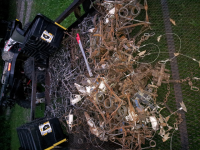PSEbowhunter
Silver Member
We usually just pile up the new traps up outside and spray them with a degreaser let them sit and then hit then with the hose. With conni's done type of degreasing is a must otherwise you won't keep them set. Just a little bump and they will fire.
We have used the rustoleum paint dip on them but taped over the dog and trigger to prevent having to scrape it off. No need to wax the Connis either. That's usually just a foothold thing. And really if you're not going to have them in the field for entire seasons i wouldn't worry about dipping them either.
If you haven't used body grip traps before i highly suggest you start by playing with the 110. And really a 220 is probably too much for a squirrel. Especially if they are reed squirrels, probably ok for fox/gray/black squirrels but still large. We use those for raccoon.
I would also look into making boxes for them. Use an idea like a mink box or weasel box. Just google those and you'll see the idea.
Just a few tips, we run everything from 110s-330s.

Pile of some of our iron on a 4x8 trailer for power washing.
We have used the rustoleum paint dip on them but taped over the dog and trigger to prevent having to scrape it off. No need to wax the Connis either. That's usually just a foothold thing. And really if you're not going to have them in the field for entire seasons i wouldn't worry about dipping them either.
If you haven't used body grip traps before i highly suggest you start by playing with the 110. And really a 220 is probably too much for a squirrel. Especially if they are reed squirrels, probably ok for fox/gray/black squirrels but still large. We use those for raccoon.
I would also look into making boxes for them. Use an idea like a mink box or weasel box. Just google those and you'll see the idea.
Just a few tips, we run everything from 110s-330s.

Pile of some of our iron on a 4x8 trailer for power washing.
